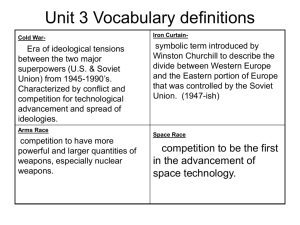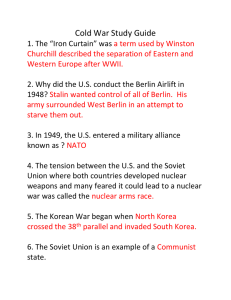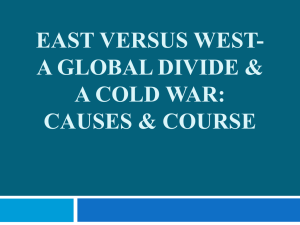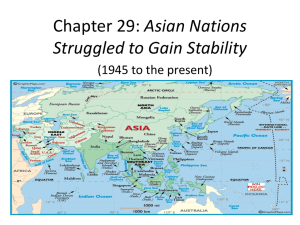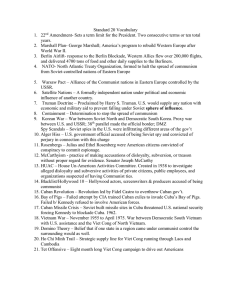Cold War PowerPoint Notes- All 4 Sections
advertisement
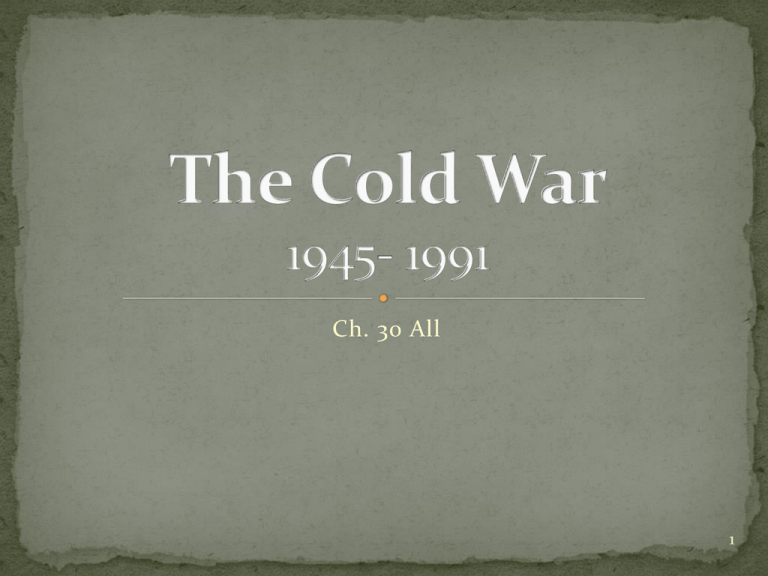
Ch. 30 All 1 Section 1 2 United States vs Soviet Union post WWII Only two superpowers that remained US led NATO/ SU led Warsaw Pact “Iron Curtain” divided democratic West from communist East Soviet Union builds the Berlin Wall 3 4 Democratic West and communist east Low paid East Germans, unhappy with communism, fled to West Berlin Soviet Union built the Berlin Wall to prevent people moving west Built in 1961: showed workers that already didn’t like communism, now they were forcibly kept from fleeing 5 6 East Germany, Poland, Hungary, and Czechoslovakia revolted against Soviet domination Hungary even tried to pull of out Warsaw pact Each region attempted to overthrow Soviets in their area, but were unsuccessful 7 One of the most terrifying aspects of the Cold War was the arms race post WWII US was the only nuclear power at first By 1949 Soviet Union had also developed nuclear weapons Both sides began to race to match the other’s new weapons Result: “balance of terror”- discouraged nuclear war 8 9 To reduce the threat both sides met at disarmament talks Mutual distrust but did reach an agreement 1969: SALT: Strategic Arms Limitation Talks Limited number of arms on each side Limited ABMs anti-ballistic missiles The agreements led to a time of détente during the 1970s Ended in 1979 when SU invaded Afghanistan 1960s: Brit, FR, & China developed nuclear weapons 1968: These nations signed Nuclear NonProliferation Treaty (NPT) 10 Began in Central Europe- spread worldwide US sees relationship of Soviet supported China and Korea Developed policies to respond to challenges anywhere in the world NATO was only one of many of several regional alliances 11 South-East Treaty Organization SEATO: US, Brit, FR, Australia, Pakistan, Thailand, New Zealand, and Philippines Central Treaty Organization CENTO: Brit, Turkey, Iran, and Pakistan Also formed individual alliances with such as Japan and South Korea Established army, navy, and air force bases around the world Soviets made alliances with governments in Africa, Asia and China- Soviet Bloc 12 Local conflicts around the world played into cold war US and Allies support one side/ Soviet bloc supported the other Political shifts added to Cold War tensions Korea and Vietnam were torn by conflict More commonly, superpowers provided weapons, training, or other aid 13 1950s: Fidel Castro organized an armed rebellion against the dictator of Cuba By 1959: Castro controlled Cuba and wanted to transform the country (Cuban Revolution) Castro sought support from Soviet Union US attempted to bring down the regime 1961: John F. Kennedy supported Bay of Pigs invasion US then imposed a trade embargo on Cuba (still today) 1962: Soviet Union sent missiles to Cuba Kennedy imposed Naval Blockade and demanded missiles be removed Premier Nikita Khrsuschev agreed to remove the missiles 14 Victory in WWII did not bring many rewards for Soviet people Command Economy Stalin continued plans for more purges before his death in 1953 Nikita Khruschev became new Soviet leader Denounced Stalin’s abuse of power- closed prison camps and eased censorship Called for a “peaceful coexistence” with the West Some citizens were still punished for speaking out against the government 15 Joseph Stalin (1941-1953) Nikita Khrushchev (1953-1964) 16 Gave citizens freedom to make economic and political choices. Valued freedom and prosperity Market Economy Prices are based on supply and demand Policy towards communism: Containment including any government facing invasion or internal rebellion by communists Nuclear threat caused people to build fallout shelters Reached its peak in 1962 with Cuban Missile Crisis 1950-1970s schools practiced air-raid drills 17 Cold war fears leads to a “red scare” in the US Americans feared communist inside the US might undermine the US government 1950 Senator Joseph McCarthy led a hunt fro suspected American Communist Became known for unproven charges, accusing innocent people and that fear created McCathyism Even accused US Army HUAC House Un-American Activist Committee sought to expose communist sympathizers, even in Hollywood’s movie industry 18 Section 3 19 20 By end of WWII, Chinese Communist had gained much of northern China After Japan’s defeat, Communists led by Mao Zedong fought a civil war against Nationalists led by Jiang Jieshi With Mao’s victory he set up People’s Republic of China Defeated nationalists fled to Taiwan China was finally under Communist control 21 22 Reasons Mao’s Communists triumphed Mao won support of China’s huge peasant population Communists redistributed land to poor peasants and ended oppression by landlords Many Chinese resented Jiang’s government and its reliance on Western “imperialist” powers Support of the Communist helped Nationalists capture rail lines and Nationalist-held cities After Communists won China over Nationalists, they conquered Tibet (1950) 1959: Dalai Lama was forced to flee the country 23 24 Mao built a Communist one-party totalitarian state Became People’s Republic of China (PRC) Communist ideology guided the government’s efforts to reshape the economy and society Discouraged practice of Buddhism, Confucianism, and other traditional beliefs Government seized property of landlords & urban business owners Opponents of Communism became “counterrevolutionaries” – then beaten, sent to labor camps, or killed 25 Chinese built dams and factories with Soviet help First Mao distributed land, then called for collectivization in an attempt to increase productivity Created communes- agricultural and industrial Proved to be a dismal failure Turned out low-quality, useless goods Cut out food output by removing incentives for individual farmers and families Bad weather led to a famine (1959-1961) 55 million Chinese are predicted to have starved to death 26 27 Slowly recovered from Great Leap Forward- reduced size of communes & a more practical approach to the economy 1966: Mao launched Great Proletarian Cultural Revolution Goal: Purge China of “bourgeois” tendencies Urged young Chinese to experience revolution first generation Teens formed Red Guards- attacked those considered bourgeois Mao had the Army restore order 28 29 Communist victory: more for Soviets and less for US Number of people under Communism tripled PRC and SU were uneasy allies in 1950s Distrust led to tensions By 1960: border clashes and ideology disputes led Soviets to withdraw all aid and advisors from China 30 US supported Jiang Jieshi and Nationalists as rightful representative China Washington refused diplomatic recognition of People’s Republic of China As Cold War dragged on, US took a second look at PRC Strategic advantages befriending Communist China An attempt to isolate SU between NATO in West and hostile China in East 1971: PRC replaced Taiwan in UN 1979: US set up formal diplomatic relations with China 31 Japan conquered the independent Korea in early 20th century After Japan’s defeat in WWII- SU and US decided to divide Korea temporarily along 38th parallel North Korea ruler Kim Il Sung became Communist ally US supported dictator but non-communist Syngman Rhee in South Korea June 1950: Kim Il Sung attacked the south as part of his “heroic struggle” to reunite Korea US organized a UN force to help South Korea 32 33 Northern forces were not stopped until Pusan Perimeter Arrival of UN troops in Sept. 1950- US led troops captured Korea’s north/south rail lines and cut off north’s troops from supplies/ammunition By November UN forces had advanced north to Yalu river- alarmed Chinese Late Nov. Mao sent hundreds of thousands of troops to help the north- forced UN back south of 38th Turned into a stalemate (Demilitarized Zone) – 1953: signed an armistice 34 North and South developed separately after armistice North: Communist command economy (SU supported) Command economy increased output for a time Late 1960s that growth slowed Kim’s self-reliance kept North isolated and poor South: Capitalist market economy (US supported) Slowly rebuilt its economy after the war Despite dictatorial rule the prosperous middle class led to fierce student protests- pushed gov. to hold elections (1987) Many North and South Koreans wanted to be reunited 35 Syngman Rhee Non-Communist South Korea Kim Il Sung Communist North Korea 36 Section 4 37 Liberation struggle tore apart region known as French Indochina 1946-1954: war against the French 1955-1975 Cold War conflict, involved US French conquered Indochina during 1800s- then overran by Japanese during WWII, but faced resistance Especially in Vietnam by guerrillas- determined to be free of all foreign rule Influenced strongly by communist opposition to Euro powers 38 39 After Japanese were defeated, French tried to re- establish their authority in Indochina (1946) Ho Chi Minh led guerrilla forces Nationalists and Communist who had fought Japanese Then fought French in 1st Indochina War 1954: Dienbienphu- unexpected Vietnamese victory convinced French to leave Vietnam Cambodia & Laos gained their independence about the same time 40 41 1954: Struggle for Vietnam became part of Cold War At international conference Western and Communists agreed to temporarily divide Vietnam North: Controlled by Communist Ho Chi Minh, supported by Soviet Union South: Led by Ngo Dinh Diem supported by United States The agreement called for elections to reunite the two Vietnams Out of fear of communist victory elections were never held 42 Ho Chi Minh Communist North Vietnam leader Ngo Dinh Diem US Supported S Vietnam leader 43 Some south Vietnamese wanted Ho Chi Minh (national hero) over US backed (foreign power) Minh’s communist rule in North forced many Catholic and pro-French Vietnamese to the south 1960s Diem faced northern supported guerrillas who opposed foreign domination Many were southern Vietnamese 44 US foreign policy planners saw the situation in Vietnam as part of the global Cold War Developed the Domino Theory US leaders wanted to prevent the spread of Communism Ho Chi Minh remained determined to unite Vietnam under communist rule He continued to aid the National Liberation Front or Viet Cong Initially US only sent supplies and advisors to South Later sent thousands of troops 45 46 Aug. 1, 1964: South Vietnamese conducted raids on North Vietnamese islands in Gulf of Tonkin Aug. 2: North attacked a nearby US Navy destroyer Maddox President Johnson reported to Congress the attacks without mentioning the South attacked first Congress passed the Gulf of Tonkin Resolution Aug. 7, 1964 Allowed President to take all necessary measures to prevent further aggression in SE Asia US began bombing targets in North Vietnam 47 48 While US sent troops to aid South, SU and China sent aid to North Many young men felt it their patriotic duty to fight Others sought refuge in other countries Americans were at a disadvantage fighting local guerrillas in a foreign land Guerrillas received aid from the North through trails in neighboring Cambodia and Laos US crossed borders to stop the trade network, bringing them into the war 49 50 By 1968 guerrilla forces came out of the jungles and attacked South Vietnamese forces in cities all around the south Assault was unexpected- during Tet (Vietnamese New Year) Communists lost many of their best troops and failed to hold any cities against US counterattacks Turning point in US public opinion of the war 51 52 Many Americans opposed the Vietnam War because of the number of POWs and MIAs US became bitterly divided over the struggle “I want to get out, but I don’t want to give up” American leaders decided they had to pull out of Vietnam Lyndon Johnson decided not to run for a second term President Nixon was under pressure to terminate American involvement Paris Peace Accord 1973 US would leave if North did not attack again, left South to determine its future and hope of reunification 53 54 Two years after American removal North Vietnam conquered South Vietnam South Vietnamese capital, Saigon, renamed Ho Chi Minh City (1976) in honor of late leader North Vietnamese capital, Hanoi, became the capital of the reunited nation 55 After American withdrawal a few dominoes did fall Cambodia and Laos ended up with governments dominated by Communist Vietnam Dominoes were stopped at previous territory of French Indochina Fighting during Vietnam War overflowed into Cambodia- US bombed North Vietnamese supply routes, the briefly invaded the country Khmer Rouge (communist guerillas) gained the ground and in 1975 overthrew Cambodian government Under Pol Pot, reign of terror to destroy Western influence 56 In newly reunited Vietnam, communist imposed harsh rule Hundreds of thousands of Vietnamese fled- most in small boats (boat people) Some settled in the US Country had to rebuild land destroyed by war Recovery slow due to lack of resources & US led embargo For years country remained in poverty 57 Section 5 58 59 Early signs of the weakness of Soviet Union, despite superpower status post WWII A Hollow victory- still a harsh rule and rewards for the people Reforms give way to repression- Khrushchev shifted from economy but remained a command economy Command economy stagnates- collective agriculture remained unproductive- could not match quality of Western goods Cracking under the burden of Military CommitmentsArms race against US put a strain on command economy 60 Had a “Vietnam” in Afghanistan- Soviets got involved in a long war in Afghanistan: years of casualties, high costs, few successes caused division at home Gorbachev tries Reforms- (1985) his attempted changes spiraled out of control: signed arms control treaties with US pulled troops out of Afghanistan called for glasnost urged perestroika allowed goods to be sold on a free market 61 62 Gorbachev’s reforms brought economic turmoil Factories were forced to close without government aid Poland to Bulgaria broke out of Soviet orbit 1989 Baltic States regained full independence in 1991 Extremists tried to overthrow Gorbachev to restore old order Gorbachev resigned, at end of 1991 Soviet republics separated to form 12 independent nations After 69 years of power, Soviet Union ceased to exist 63 With glasnost and perestroika in Soviet Union, East Europeans sought greater freedoms and demanded end to Soviet domination Hungary quietly reforms: through years of progressively moving away from communism 1988-1989: communist government allowed greater freedoms, new political parties allowed to form Poland embraces Solidarity: 1980 ignited strikes that helped to shatter Soviet satellite empires- organized Solidarity and demanded change Poland had to outlaw the union and arrest its leaders, but unrest continued Pope John Paul II’s visit denounced communist policies 64 East Germans Demand Change: resisted Gorbachev’s calls for change, banned Soviet publications, & blocked moves towards a market economy Many fled to West Germany by going through Hungary or Austria, other held major demonstrations By 1989 a democracy movement swept across Eastern Europe – communist governments began to fall one by one Czechoslovakia: Vaclav Havel elected President Germany: Berlin Wall gates were opened and movement towards unification Romania’s dictator overthrown and executed Warsaw Pact dissolved 1991 65 During WWII Nazi Germans divided Czechoslovakia Was reunified under communist rule after the war 1989 when communist lost power some Slovaks began to call for independence 1992 Slovaks and Czechs peacefully agreed to divide Czechoslovakia into Slovakia and Czech Republic 66 67 68 China builds on Deng’s Reforms: People’s Republic of China accelerated compromises with capitalism introduced by Deng Xiaoping Economic boom China remained Communist and worked to preserve one-party rule and their own power Vietnam and North Korea differ: 1990s: Communist Vietnam opened up to the world Established diplomatic relations with US North Korea refused to reform its economy or political system Hundreds of thousands of N. Koreans died of starvation or malnutrition during 1990s 69 70 Now, only US could project its power around the world Seemed unsure of their proper role in the world “world’s policeman”- some for it, others opposed the idea Many people around the world were not as pleased to see how powerful the US had become Produced mixed reactions with in the US as well as around the World 71




